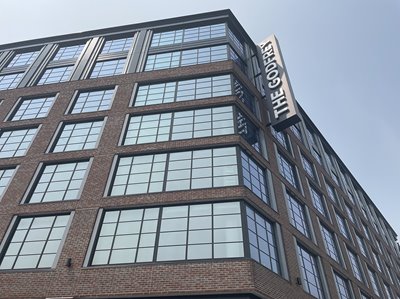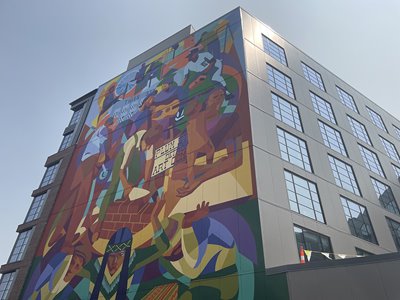
The Godfrey Hotel Detroit is a 227-room boutique hotel in the city’s historic Corktown neighborhood. The $2.4 million worth of sheet metal work the hotel required was done by SMACNA Detroit member CASS Sheet Metal.
The oldest neighborhood in the Motor City is now the site of its newest hotel. In August 2023, the 227-room Godfrey Hotel opened in Corktown, a Detroit neighborhood with roots going back to 1834. With its extensive use of brick, glass and metal, the $75-million boutique hotel is designed to blend into a historic community that still has red brick-paved streets and rowhouses dating to the 1850s.
Ensuring the project’s sheet metal work maintained the hotel architect’s vision was the job of Custom Architectural Sheet Metal Specialists. Better known as CASS Sheet Metal, the Detroit SMACNA member has worked on many high-profile projects in the city and region, including Michigan Central Station, a 1912 National Historic Landmark under restoration.
Unlike the 111-year-old Detroit train station, the Godfrey is a new-construction project. That presents special challenges, says CASS owner and President Glenn Parvin.
“The design has a lot of unique elements in transitions between masonry and sheet metal,” Parvin says. “It gives the look, at least to me, of revitalized loft construction in an old industrial building. They tied all elements together.”
CASS won the $2.4 million contract to fabricate and install all of the hotel’s sheet metal work, which encompassed more than 45,000 square feet and included 3-inch insulated Centria wall panels and aluminum composite material (ACM) panels.
“Everything on the project was custom fabricated,” Parvin explains.
Sheet metal shop was close by
Fortunately, CASS’ sheet metal shop was only 15 minutes away from the construction site, making transportation and coordination easier. Panels were fabricated in its shop and then driven to the worksite several times a week. Installing them required CASS employees to stand on lifts more than 80 feet in the air.
The project took about 45 weeks, with 10 to 12 CASS employees working on site through a cold
Michigan winter.
Parvin says that winter weather, along with the space-constrained job site and working so high off the ground were among the hotel project’s biggest challenges.

A closeup look of the hotel’s metal window panels and adjacent brick work, which required special efforts by CASS workers.
“Things go a lot slower on a tight site and when you’re 80 feet in the air,” he says. “Labor hours were significantly higher. And what played a role in that was the timing of the job working through the winter and the amount of equipment required to run the project with three or four 85-foot man lifts in the air and having those man lifts in the air for four or five months. That chews up a lot of labor and a lot of equipment costs.”
Project changes
And, as often happens, some of the project specifications changed during construction, which was another challenge that required CASS to adapt.
“The window panels changed dimensions. What was supposed to be a nominal 16-inch panel had to be an 18-inch panel, 15-inch panel, tapered,” Parvin says. “And as the finishing contractor, we often had to make up for the differences between various systems like the window to the brick and framing, and concrete pours did not meet exacting tight tolerances."
Parvin wasn’t surprised.
“We expected some of it to happen,” he says. “Because when you’re dealing with concrete tying into stud work wall to wall to wall, and you go in vertically, you have to install adjusted girts because the panel systems that you have to install have to be plumb to be watertight and weather-tight. We had hat channels that we had to put on that ranged in size from three-eighths of an inch to an inch and a half to 2 inches in some cases, so that we could take the plane between floor to floor and the concrete so that we can bridge problems.”
Such changes caused the job to take more time than expected, Parvin adds.
“Unfortunately, when projects are bid to be competitive in the marketplace, you put on the rose-colored glasses. It’s going to be a ‘perfect build and 70 degrees and sunny every day with no wind.’”
Parvin says the reality was different.
“And while we finished the project and we covered some cost in doing the project, I think that we anticipated it to certainly go a lot faster,” he says.
Still, despite those challenges, Parvin says he’s “ecstatic” with how the project turned out in the end. On a recent afternoon, he visited the hotel for the first time since it opened to the public. He was impressed with the facility.
As a lifelong resident of the Detroit area, Parvin says he appreciated the colorful mural on one side of the hotel that pays tribute to the hardworking residents of the region. The mural also commemorates Tiger Stadium, the longtime home of the Detroit Tigers pro baseball team that once stood across the street.
The Godfrey Detroit is part of a five-hotel chain that includes properties in Los Angeles, Tampa, Chicago and Boston. It has 6,292 square feet of meeting space, a lobby bar and restaurant, and a rooftop lounge that features a retractable glass ceiling and walls.
It was designed by Neumann/Smith Architecture of Detroit and Boston-based Manfredi Architects. The general contractor was a joint venture between Christman Co. of Detroit and Norcon Inc. in Chicago.